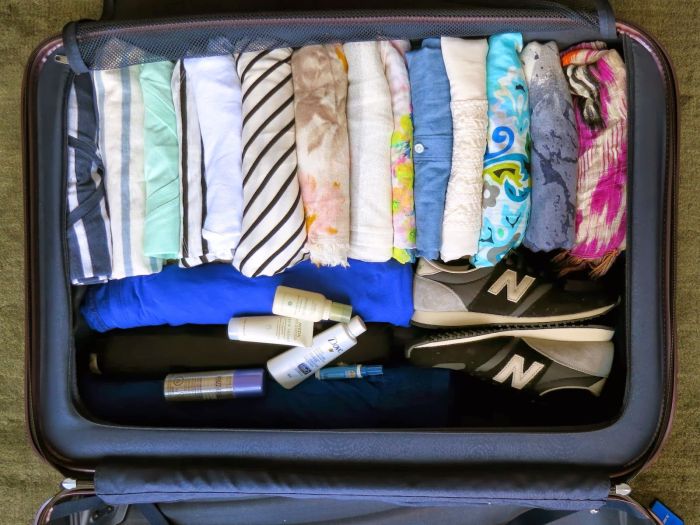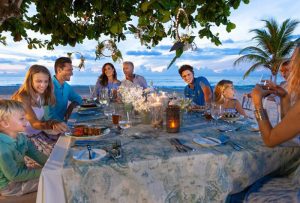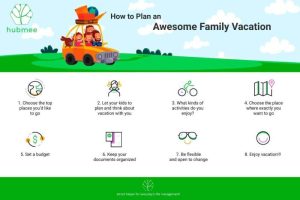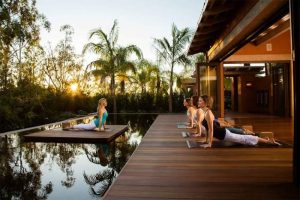
Conquering the art of packing light is a traveler’s holy grail, promising stress-free journeys and a hefty saving on baggage fees. This guide delves into practical strategies for minimizing your luggage while maximizing your experience. We’ll explore essential packing lists, efficient packing techniques, airline baggage policies, and savvy travel hacks to ensure your next adventure is both enjoyable and budget-friendly.
From choosing versatile clothing items to mastering the art of rolling versus folding, and understanding the often-confusing world of airline baggage restrictions, we’ll equip you with the knowledge and tools to pack smart. This guide also addresses the importance of travel insurance and offers additional tips for a smoother, more enriching travel experience.
Packing Light
Packing light is a crucial skill for any traveler, allowing for greater mobility, reduced stress, and avoidance of hefty baggage fees. This section focuses on essential items for a one-week trip, strategies for efficient packing, and the benefits of utilizing packing cubes.
Essential Clothing Items for a One-Week Trip
Choosing versatile clothing items is key to packing light. The following table Artikels essential clothing categorized by function for a one-week trip. Remember to consider the climate and activities planned for your destination.
| Versatile Tops | Bottoms | Outerwear | Undergarments & Accessories |
|---|---|---|---|
| 2-3 t-shirts | 1 pair of jeans or sturdy pants | Light jacket or sweater | 7 pairs of underwear |
| 1 lightweight long-sleeved shirt | 1 pair of versatile shorts or skirt | Rain jacket (if needed) | 7 pairs of socks |
| 1 nicer top (for evenings out) | 1 pair of comfortable walking shoes | Swimsuit (if applicable) | |
| Small toiletry bag |
Versatile Clothing Items Packing List
A carefully curated selection of versatile items maximizes your wardrobe options while minimizing the amount of clothing you need to pack.
- Neutral-colored bottoms: A pair of dark-wash jeans or versatile chinos can be paired with various tops.
- Mix-and-match tops: Choose tops in neutral colors that can be layered or worn alone, such as a white t-shirt, a black long-sleeved shirt, and a patterned blouse.
- Versatile outerwear: A lightweight jacket or sweater is ideal for layering and protection against cooler temperatures.
- Scarf or shawl: This can add warmth, style, or even serve as a makeshift pillow on the plane.
- Comfortable walking shoes: Choose shoes that are broken-in and suitable for walking long distances.
Rolling Clothes for Efficient Packing
Rolling clothes is a space-saving technique that minimizes wrinkles and maximizes packing efficiency.Imagine a t-shirt laid flat. First, button any buttons or zip any zippers. Next, lay the garment flat and smooth out any wrinkles. Starting from one side, roll it tightly towards the opposite end, creating a compact cylinder. Repeat this process for each item.
This method prevents creasing and utilizes space more effectively than folding.
Utilizing Packing Cubes Effectively
Packing cubes are fabric containers used to compress clothing and organize a suitcase. They separate different types of clothing (e.g., tops, bottoms, underwear) and compress items, creating more space and preventing wrinkling. To utilize them effectively, fill each cube completely, rolling or tightly folding items before placing them inside. Larger cubes are suitable for bulky items like sweaters, while smaller cubes are ideal for underwear and accessories.
Using different colored cubes can further enhance organization and speed up unpacking.
Minimizing Toiletries
Packing light often means making smart choices about what toiletries to bring. Reducing the weight and volume of your toiletries can significantly impact your luggage’s overall weight and save you money on baggage fees. Careful planning and the selection of appropriate products are key to achieving this.
Travel-Sized Toiletries and Alternatives
Choosing travel-sized versions of your favorite products is a good starting point, but further optimization is possible. The following table Artikels common toiletries and suggests lighter, more efficient alternatives:
| Item | Travel Size | Lighter Alternative | Notes |
|---|---|---|---|
| Shampoo | 3-ounce bottle | Solid shampoo bar | Lasts longer, eliminates liquid restrictions. |
| Conditioner | 3-ounce bottle | Solid conditioner bar | Similar benefits to solid shampoo. |
| Body Wash | 3-ounce bottle | Bar soap | Compact, lasts longer than liquid body wash. |
| Lotion | 3-ounce bottle | Solid lotion bar | More compact and less prone to spillage. |
| Toothpaste | Travel-sized tube | Toothpaste tablets | Significantly reduces weight and volume. |
| Sunscreen | 3-ounce bottle | Sunscreen stick | Convenient and avoids spills. |
| Deodorant | Stick deodorant | Solid deodorant | Often more compact than stick versions. |
Advantages of Solid Toiletries
Solid toiletries, such as shampoo bars and conditioner bars, offer several advantages over their liquid counterparts. They are significantly lighter and more compact, taking up less space in your luggage. They also often last longer, reducing the need to repackage or purchase replacements during your trip. Finally, they eliminate the risk of spills and leaks associated with liquid containers, ensuring a cleaner and less stressful travel experience.
For example, a single shampoo bar can often replace several travel-sized bottles of liquid shampoo, saving considerable weight and space.
Decanting Liquids into Smaller Containers
When using liquid toiletries, decanting them into smaller, TSA-approved containers is a common strategy for minimizing weight and volume. The Transportation Security Administration (TSA) allows liquids in containers of 3.4 ounces (100ml) or less, provided they are placed in a single, quart-sized, clear, resealable plastic bag. Remember to carefully label the smaller containers to avoid confusion. Always ensure the containers are leak-proof to prevent spills and potential damage to your belongings.
For instance, reusable travel-sized bottles are widely available and can be easily refilled.
Strategies for Minimizing the Number of Toiletries
To minimize the overall number of toiletries, consider multi-purpose products. A single bar soap can serve as both body wash and shampoo in a pinch, while a tinted moisturizer can replace both sunscreen and foundation. Prioritize essential items and leave behind less-necessary products. Also, check if your hotel provides basic amenities like shampoo and conditioner to further reduce your packing load.
Careful planning and selection of versatile products can significantly streamline your toiletry kit.
Avoiding Excess Baggage Fees
Excess baggage fees can significantly impact your travel budget. Understanding airline policies and employing smart packing strategies are crucial for avoiding these unexpected costs. This section will equip you with the knowledge and techniques to navigate baggage restrictions effectively and travel light.
Airline Baggage Policies
Airline baggage policies vary considerably. Understanding these differences is key to packing appropriately and avoiding fees. The following table compares the baggage allowances of three major airlines – these are examples and should be verified with the airlines directly before travel, as policies are subject to change.
| Airline | Carry-on Weight/Size | Checked Baggage Weight/Size (First Bag) | Checked Baggage Fees (Additional Bags) |
|---|---|---|---|
| Example Airline A | 7kg/55x40x20cm | 23kg/158cm linear | Varies depending on route and weight; check their website for specific details. |
| Example Airline B | 10kg/56x36x23cm | 20kg/158cm linear | $50-$100 per bag, depending on destination and booking class. |
| Example Airline C | 8kg/56x45x25cm | 25kg/158cm linear | Fees vary significantly based on route and weight; refer to their online booking tool for exact pricing. |
Typical Weight and Size Restrictions
Generally, carry-on baggage allowances range from 7kg to 10kg, with maximum linear dimensions (length + width + height) between 115cm and 158cm. Checked baggage allowances typically range from 20kg to 32kg, again with linear dimension limits usually around 158cm. However, these are just averages; specific limits vary significantly depending on the airline, your ticket class (economy, business, first), and your destination.
Always check the specific requirements on your airline’s website before your flight.
Weighing Luggage Accurately
Accurately weighing your luggage before heading to the airport is crucial. Many post offices and luggage stores offer luggage scales for a small fee. Alternatively, some home scales (bathroom scales, for example) can be used, but ensure you subtract your own weight if using this method. A more precise method is to use a luggage scale that attaches to your bag’s handle and provides a digital reading.
This allows you to adjust your packing accordingly before you leave home, preventing costly surprises at the airport.
Strategies for Avoiding Overweight Baggage Fees
Strategically choosing outfits is a key tactic for avoiding overweight baggage. Select versatile clothing items that can be mixed and matched to create multiple outfits. Opt for lightweight fabrics such as merino wool or quick-drying synthetic materials. Roll your clothes instead of folding them to save space and reduce wrinkles. Consider wearing your bulkiest items, such as boots or a heavy jacket, on the plane to reduce the weight in your checked bag.
Prioritize essential items and leave behind unnecessary extras. Remember to always check the weight of your bag before leaving for the airport, allowing for adjustments if necessary.
Travel Hacks for Light Packing
Packing light is a skill that significantly enhances the travel experience, reducing stress and saving money on baggage fees. Mastering this skill involves a combination of strategic planning, clever packing techniques, and a willingness to embrace minimalism. This section explores practical strategies and helpful tips to make your next trip lighter and more enjoyable.
Wearing Bulky Items
Wearing your bulkiest items, such as boots, jackets, and sweaters, on the plane is a highly effective way to save space in your luggage. This simple strategy frees up valuable room for other essentials. Consider the climate of your destination and choose your outfit accordingly. A bulky coat worn on the plane eliminates the need to pack it, saving significant space.
- Wear your heaviest shoes or boots.
- Layer clothing to maximize warmth and minimize bulk.
- Opt for versatile clothing items that can be mixed and matched.
- Choose lightweight fabrics that won’t take up much space.
Utilizing Laundry Services
For longer trips, utilizing laundry services can dramatically reduce the amount of clothing you need to pack. This is especially beneficial for trips exceeding a week, where carrying enough clothes for the entire duration becomes impractical. Many hotels offer laundry services, and laundromats are readily available in most cities. Planning for laundry days allows you to pack a smaller, more manageable wardrobe.
Packing Strategies for Different Trip Types
Packing strategies should be tailored to the specific type of trip. A business trip requires a different approach than a backpacking adventure. Understanding the context of your journey allows for optimal packing efficiency.
- Business Trip: Prioritize wrinkle-resistant clothing, a professional-looking bag, and essential business documents. A carry-on suitcase is often sufficient.
- Backpacking Adventure: Focus on lightweight, durable clothing and gear suitable for outdoor activities. Invest in compression sacks to minimize volume and maximize space. A durable backpack is crucial.
Efficient Space Utilization in a Suitcase
Maximizing space within a suitcase is key to light packing. Proper organization and techniques can make a significant difference. Consider rolling your clothes instead of folding them to save space and minimize wrinkles. Utilize packing cubes to compress clothing and keep items organized.
- Roll clothes instead of folding them.
- Use packing cubes to compress clothing and organize items.
- Fill empty spaces with smaller items, such as socks and underwear.
- Place heavier items at the bottom of the suitcase.
- Utilize the space in shoes to store smaller items, like socks or jewelry.
Travel Insurance

Securing travel insurance is a crucial step in planning any trip, regardless of its duration or destination. It provides a financial safety net against unforeseen circumstances that can disrupt your travel plans and potentially lead to significant expenses. Understanding the different types of coverage and the benefits they offer is essential for making an informed decision.Travel insurance policies vary widely in their coverage, but most offer protection against a range of issues.
The level of coverage and the specific events covered will differ depending on the policy and the provider. It’s vital to carefully review the policy documents before purchasing to ensure it meets your individual needs and expectations.
Types of Travel Insurance Coverage
Travel insurance policies typically offer several types of coverage. Common coverages include trip cancellation or interruption insurance, which reimburses you for prepaid, non-refundable travel expenses if your trip is cancelled or interrupted due to covered reasons such as illness, severe weather, or family emergencies. Medical expense coverage is another crucial component, providing financial assistance for medical treatment and evacuation if you fall ill or are injured during your travels.
Baggage loss or delay coverage can help replace or reimburse you for lost or delayed luggage. Other potential coverages may include emergency medical evacuation, personal liability protection, and even flight accident insurance.
Benefits of Purchasing Travel Insurance Before a Trip
Purchasing travel insurance before your trip offers several key advantages. Primarily, it safeguards you against financial losses resulting from unexpected events. For instance, if a sudden illness prevents you from traveling, your non-refundable flight and accommodation costs could be covered. Furthermore, travel insurance can provide peace of mind, allowing you to focus on enjoying your trip knowing that you have protection in place should something go wrong.
This peace of mind is invaluable, particularly for trips involving significant financial investment or travel to unfamiliar locations. Lastly, some insurance policies also offer 24/7 emergency assistance services, providing valuable support in crisis situations.
Comparison of Travel Insurance Providers
Different travel insurance providers offer varying levels of coverage and pricing. Factors such as your age, destination, trip length, and the type of activities planned can influence the cost and coverage options available. Some providers specialize in specific types of travel, such as adventure travel or backpacking, while others cater to a broader range of travelers. Comparing policies from several providers is crucial to finding the best coverage at the most competitive price.
Consider factors like the policy’s exclusions, the claims process, and customer reviews when making your comparison. For example, World Nomads and Allianz Global Assistance are well-known providers with different strengths and weaknesses depending on the traveler’s specific needs.
Filing a Claim with Your Travel Insurance Provider
The claims process varies depending on the specific provider, but generally involves reporting the incident as soon as possible. You’ll usually need to provide documentation supporting your claim, such as medical bills, police reports, or flight cancellation confirmations. Carefully review your policy documents to understand the specific requirements for filing a claim and the necessary documentation. Most providers have a dedicated claims department that can guide you through the process.
Promptly submitting all necessary documentation will expedite the claims process and increase your chances of a successful claim. Remember to keep copies of all submitted documents for your records.
Travel Photography Tips
Capturing stunning travel photos doesn’t require an arsenal of expensive equipment. With a little planning and know-how, you can create memorable images that perfectly encapsulate your adventures, even with minimal gear. This section provides practical advice on optimizing your travel photography, focusing on efficiency and impactful results.
The key to successful travel photography lies in a combination of preparation, mindful shooting, and effective post-processing. By understanding light, composition, and editing techniques, you can elevate your travel photos from snapshots to works of art, regardless of your equipment’s sophistication.
Capturing Stunning Travel Photos with Minimal Equipment
Utilizing readily available tools and understanding fundamental photographic principles allows for the creation of impactful travel images. Even a smartphone camera can produce excellent results with the right approach.
Consider these aspects: The time of day significantly impacts the quality of light. The “golden hour,” the period shortly after sunrise and before sunset, provides soft, warm light that is ideal for photography. Similarly, the “blue hour,” occurring just before sunrise and after sunset, offers a unique, cool-toned ambiance. Experiment with different angles and perspectives to add visual interest.
Get low to the ground for unique perspectives, or find elevated vantage points for sweeping landscapes. Pay attention to composition, employing the rule of thirds – placing your subject off-center for a more balanced and visually appealing image. Finally, ensure your subject is in focus and properly exposed.
Editing Travel Photos for Social Media
Post-processing is crucial for enhancing your travel photos and making them visually appealing for social media platforms. While extensive editing software offers powerful features, many free and user-friendly mobile apps can achieve excellent results.
Basic editing techniques include adjusting brightness, contrast, and saturation to optimize the image’s overall look. Cropping and straightening can improve composition. Many apps offer filters that add a stylistic touch, but use these sparingly to avoid making the image look unnatural. Consistency in your editing style across your social media feed creates a cohesive and professional look.
Consider using presets or creating your own to maintain a consistent brand aesthetic.
Benefits of Using a Lightweight Camera for Travel
A lightweight camera, such as a mirrorless camera or a high-quality smartphone, offers several advantages for travel photography. Its portability allows for spontaneous shots and minimizes the burden of carrying heavy equipment.
The reduced weight translates to greater comfort and freedom during your travels. You’ll be more likely to capture those unexpected moments without the hassle of lugging around bulky gear. Many lightweight cameras offer impressive image quality, rivaling that of heavier DSLRs in many situations. This means you can capture professional-looking photos without compromising on quality. The ease of use and intuitive interfaces of many lightweight cameras make them accessible even for beginners.
Planning Photo Opportunities Before a Trip
Pre-trip planning is essential for maximizing your photography opportunities. Researching potential locations and identifying ideal shooting times allows you to optimize your time and capture the best possible images.
Use online resources such as Google Earth, travel blogs, and Instagram to scout locations and understand the lighting conditions at different times of day. Consider the weather conditions and plan accordingly, as poor weather can significantly impact your photography. Creating a detailed itinerary that incorporates photography stops ensures you don’t miss any key opportunities. This proactive approach ensures you are prepared to capture the most stunning images possible during your trip.
Travel Tips Beyond Packing
Packing light is a crucial aspect of travel, but it’s only one piece of the puzzle. A truly enjoyable and stress-free trip hinges on several other factors that can significantly enhance your overall experience. This section explores key areas beyond packing that will help you make the most of your travels.
Careful planning and preparation before, during, and after your trip are essential for a smooth and memorable experience. Consider these factors to maximize your enjoyment and minimize potential hassles.
General Travel Tips for Enhanced Experiences
Beyond the physical act of packing, numerous strategies can improve your travel experience. These tips address various aspects, from pre-trip planning to on-the-ground navigation and interaction with locals.
- Learn basic phrases in the local language: Even a few words like “hello,” “thank you,” and “please” can go a long way in showing respect and facilitating communication.
- Make copies of important documents: Keep copies of your passport, visa, driver’s license, and travel insurance information separate from the originals. Store them digitally as well as physically in different locations.
- Inform your bank and phone provider of your travel plans: This prevents your cards from being blocked due to unusual activity and ensures you can access your mobile data if needed.
- Stay connected: Consider purchasing a local SIM card or investing in an international roaming plan to stay connected with loved ones and access maps and other essential apps.
- Be aware of local customs and traditions: Research the local culture and etiquette before you go to avoid unintentional offenses.
- Stay hydrated: Dehydration can significantly impact your energy levels and overall well-being, especially in hot climates. Carry a reusable water bottle and refill it regularly.
- Plan for unexpected delays: Build buffer time into your itinerary to account for potential flight delays, traffic jams, or other unforeseen circumstances.
Choosing the Right Accommodation
Accommodation plays a significant role in shaping your travel experience. The best choice depends on your travel style, budget, and priorities.
- Budget Travelers: Hostels offer affordable shared rooms and opportunities to meet fellow travelers. Budget hotels provide basic amenities at a reasonable price.
- Luxury Travelers: High-end hotels and resorts provide exceptional service, luxurious amenities, and often include personalized concierge services.
- Adventure Travelers: Glamping sites, eco-lodges, or cabins offer unique experiences immersed in nature, catering to adventurous souls.
- Family Travelers: Family-friendly hotels or vacation rentals with amenities like kitchens and multiple bedrooms provide comfortable and convenient accommodations for families.
- Solo Travelers: Boutique hotels or guesthouses offer a more intimate and personalized experience, ideal for independent exploration.
Navigating Unfamiliar Cities Efficiently
Efficient navigation is key to maximizing your time and minimizing stress in unfamiliar cities. Several strategies can help you get around smoothly.
- Utilize public transportation: Subways, buses, and trams are often the most cost-effective and efficient ways to navigate large cities.
- Download offline maps: GPS navigation apps are indispensable for exploring unfamiliar areas, especially when you lack internet access.
- Learn basic route planning: Familiarize yourself with the city’s layout and major landmarks before you arrive.
- Use ride-sharing services: Apps like Uber and Lyft can provide convenient and reliable transportation, particularly for shorter distances or late-night travel.
- Consider walking tours: Walking tours offer a great way to explore a city at your own pace while learning about its history and culture from a local guide.
Cultural Sensitivity in Travel
Respecting local customs and traditions is paramount for a positive travel experience and avoiding cultural misunderstandings. Demonstrating cultural sensitivity shows respect for the local population and enriches your own travel experience.
- Research local customs before you go: Understanding basic etiquette, dress codes, and social norms can prevent unintentional offenses.
- Learn a few basic phrases in the local language: Showing an effort to communicate in the local language is greatly appreciated.
- Be mindful of your behavior in public spaces: Respect quiet zones, avoid loud conversations, and be considerate of others.
- Support local businesses: Patronizing local restaurants, shops, and markets helps contribute to the local economy and provides authentic experiences.
- Be respectful of religious sites: Dress modestly and follow any specific guidelines for visiting religious sites.
Travel Visa Requirements

Navigating international travel often involves understanding and securing the necessary travel visas. The process can seem daunting, but with proper planning and preparation, obtaining a visa can be straightforward. This section Artikels the process, required documents, and tips for a smoother application.The process of obtaining a travel visa varies significantly depending on your citizenship, your destination country, and the purpose of your visit.
Generally, it involves completing an online application form, submitting supporting documentation, and potentially attending an interview at the embassy or consulate of your destination country. Some countries offer e-visas which can be obtained entirely online, while others require a more traditional application process. Processing times also vary widely, ranging from a few days to several months.
Visa Application Documents
The specific documents required for a visa application vary depending on the country and the type of visa. However, some common documents include a valid passport with sufficient remaining validity, a completed visa application form, a recent passport-sized photograph meeting specific requirements, proof of sufficient funds to cover your trip, proof of accommodation (hotel bookings, invitation letter, etc.), and a return or onward ticket.
For certain visa types, additional documentation may be required, such as a letter of invitation from a sponsor in the destination country, proof of employment or academic enrollment, or a detailed travel itinerary.
Speeding Up the Visa Application Process
Submitting a complete and accurate application is crucial for a faster processing time. Ensure all required documents are meticulously prepared and organized according to the embassy or consulate’s instructions. Double-check all information for accuracy to avoid delays caused by corrections or requests for additional information. Applying well in advance of your intended travel dates is also highly recommended to allow ample time for processing.
Utilizing online application systems where available can streamline the process. Consider using a reputable visa processing service if you need assistance with the application process, but always verify their legitimacy.
Consequences of Traveling Without a Visa
Traveling to a country without the appropriate visa can have serious consequences. These can range from being denied entry at the border and being sent back to your origin country, to facing fines, imprisonment, or deportation. It can also significantly impact your future travel plans, making it more difficult to obtain visas in the future. It’s crucial to always verify visa requirements well in advance of your travel dates and to ensure you have all the necessary documentation before departing.
The potential repercussions of non-compliance far outweigh any perceived inconvenience of obtaining the correct visa.
Urban Escapes & Vacation Packages
Urban escapes and vacation packages offer diverse ways to experience exciting destinations, balancing convenience with personalized travel. Choosing between pre-packaged deals and independent planning hinges on individual priorities, such as budget, time constraints, and desired level of control. This section explores the benefits and drawbacks of each approach, offering guidance on selecting the ideal option for your next urban adventure.
Sample Long Weekend Urban Escape Itinerary: Chicago
This itinerary focuses on a long weekend in Chicago, highlighting a blend of iconic landmarks and local experiences. Accommodation suggestions cater to different budgets.
Day 1: Arrive in Chicago and check into your accommodation. Options range from budget-friendly hostels like The Freehand Chicago to mid-range hotels such as the Hotel Lincoln, or luxury stays at the Peninsula Chicago. Spend the afternoon exploring Millennium Park, capturing a photo with “The Bean” (Cloud Gate), and enjoying the Crown Fountain. In the evening, take an architectural boat tour on the Chicago River for stunning city views.
Day 2: Visit the Art Institute of Chicago, home to a vast collection of masterpieces. Afterwards, explore the vibrant neighborhood of Wicker Park, known for its independent boutiques and trendy cafes. Enjoy dinner in the lively Lincoln Park area, known for its diverse culinary scene.
Day 3: Spend the morning at Navy Pier, enjoying the Ferris wheel and various attractions. In the afternoon, visit the Museum of Science and Industry or explore the Magnificent Mile for some shopping. Enjoy a final Chicago-style deep-dish pizza for dinner before heading to the airport.
Day 4: Depart from Chicago.
Comparison of Vacation Packages
Vacation packages vary widely depending on the destination and provider. For example, a package to Paris might include airfare, hotel accommodations at a centrally located hotel, and guided tours of major attractions like the Eiffel Tower and the Louvre Museum. In contrast, a package to a tropical destination like Cancun might emphasize all-inclusive resorts with unlimited food and drinks, beach access, and various water sports activities.
The level of customization also differs significantly. Some packages offer limited flexibility, while others allow for the selection of specific hotels, flights, and activities.
Advantages and Disadvantages of Booking Vacation Packages versus Independent Planning
Booking a vacation package offers the convenience of pre-arranged travel plans, often at a discounted price compared to booking each component separately. However, it limits flexibility and customization. Independent planning provides greater control over every aspect of the trip, allowing for personalized experiences but requires more time and effort in research and booking.
Vacation Packages: Advantages include simplified planning, potentially lower costs, and a structured itinerary. Disadvantages include less flexibility, limited choices, and potential for hidden fees.
Independent Planning: Advantages include complete control, customization, and the potential for unique experiences. Disadvantages include increased time commitment, higher potential costs if not planned carefully, and the risk of logistical issues.
Factors to Consider When Choosing a Vacation Package
Selecting the right vacation package involves careful consideration of several key factors.
Before making a decision, carefully weigh these aspects to ensure the package aligns with your travel style and expectations.
- Budget: Determine your overall budget and compare package prices to ensure they fit within your financial constraints.
- Travel Dates: Consider the best time to visit your chosen destination, taking into account weather conditions and potential crowds.
- Destination: Research the destination thoroughly to ensure it aligns with your interests and preferences.
- Included Services: Carefully review the services included in the package, such as flights, accommodation, meals, and activities.
- Reputation of the Provider: Check online reviews and ratings of the tour operator or travel agency before booking.
- Flexibility and Customization: Assess the level of flexibility offered by the package and whether it can be customized to meet your specific needs.
- Cancellation Policy: Understand the cancellation policy in case of unforeseen circumstances.
Vacation Programs & Venture Capital (Tangential, for context exploration)
The increasing recognition of the importance of employee well-being and its direct correlation with productivity has led many companies to implement comprehensive vacation programs. Simultaneously, the travel industry is experiencing a surge in innovation, fueled in part by venture capital investment. Examining the interplay between these two areas reveals interesting synergies and opportunities for growth.Employee vacation programs, when well-structured, offer significant benefits.
They contribute to reduced stress levels, improved mental and physical health, and increased job satisfaction among employees. This, in turn, leads to higher productivity, reduced absenteeism, and improved employee retention rates. Companies offering generous vacation policies often find themselves more competitive in attracting and retaining top talent. Conversely, inadequate vacation policies can result in burnout, decreased morale, and ultimately, a decline in productivity and profitability.
Studies have shown a direct correlation between adequate vacation time and improved employee performance. For example, a company that implemented a four-week paid vacation policy saw a 20% reduction in employee turnover within a year.
Impact of Vacation Programs on Employee Well-being and Productivity
Generous vacation policies directly impact employee well-being by allowing for much-needed rest and relaxation. This time away from work allows employees to recharge, pursue personal interests, and return to their jobs feeling refreshed and motivated. The positive impact on productivity is significant, as rested and rejuvenated employees are generally more focused, efficient, and creative. The implementation of such programs often involves careful consideration of employee needs, ensuring equitable access to vacation time and flexible scheduling options.
The benefits extend beyond the individual employee, impacting the overall organizational culture and contributing to a more positive and productive work environment. This fosters a sense of loyalty and commitment, leading to a more stable and efficient workforce.
Venture Capital Funding in Travel-Related Startups
Venture capital plays a crucial role in fostering innovation within the travel industry. Startups focusing on areas such as sustainable tourism, personalized travel planning, innovative booking platforms, and technological advancements in travel logistics often require significant funding to develop and scale their operations. Venture capitalists provide not only financial resources but also valuable expertise and mentorship, helping these startups navigate the complexities of the market and achieve sustainable growth.
For instance, a recent investment round in a sustainable tourism startup focused on eco-friendly accommodations attracted significant funding, enabling the company to expand its operations and reach a wider audience. This demonstrates the willingness of investors to back ventures aligned with environmentally conscious travel.
Synergies Between Travel and Venture Capital Investments
The synergies between travel and venture capital are substantial. The travel industry is ripe for disruption, with numerous opportunities for innovation in areas such as personalized travel experiences, sustainable tourism practices, and improved travel technology. Venture capital investments can help accelerate the development and adoption of these innovations, ultimately benefiting both travelers and the industry as a whole.
For example, investments in AI-powered travel planning tools can lead to more efficient and personalized travel experiences, while investments in sustainable tourism startups can contribute to environmentally responsible travel practices. This mutual benefit drives growth in both sectors.
Hypothetical Business Plan: “EcoTrek” – Sustainable Adventure Tourism
EcoTrek is a sustainable adventure tourism startup focusing on providing immersive and eco-conscious travel experiences in remote, natural locations. Our business model emphasizes minimizing environmental impact, supporting local communities, and providing unique and unforgettable experiences for adventure travelers. We seek $2 million in seed funding to develop our online platform, establish partnerships with local guides and communities, and expand our offering of sustainable adventure tours.
Our financial projections show profitability within two years, based on a projected annual growth rate of 40%. Key competitive advantages include our commitment to sustainability, focus on unique experiences, and strong partnerships with local communities. The funding will be allocated to technology development (30%), marketing and sales (30%), operational expansion (25%), and team building (15%). EcoTrek’s strong commitment to sustainability aligns perfectly with the growing trend of responsible travel, making it an attractive investment opportunity for venture capitalists interested in both financial returns and positive social impact.
Mastering the art of light packing is more than just saving money; it’s about reclaiming freedom and spontaneity on your travels. By following the tips and strategies Artikeld in this guide, you can confidently navigate airports, explore new destinations with ease, and focus on creating lasting memories rather than worrying about excess baggage fees. Remember, thoughtful planning and efficient packing techniques are your keys to a stress-free and enjoyable travel experience.
Embrace the journey, and pack light!
FAQ Section
What if my bag is slightly overweight, but not significantly so?
Many airlines offer a grace period for slightly overweight bags, but it’s best to check their specific policy. Consider removing a few non-essential items before checking in to avoid unexpected fees.
Can I bring liquids in my carry-on bag?
Yes, but they must be in containers of 3.4 ounces (100ml) or less and fit inside a quart-sized, clear, resealable plastic bag.
What should I do if my luggage is lost or damaged?
Immediately report the issue to the airline at the airport. Thoroughly document the incident and file a claim with the airline and/or your travel insurance provider.
How can I find the best deals on travel insurance?
Compare quotes from multiple providers, considering the level of coverage you need. Look for discounts and read reviews before purchasing.






